Indiana is a beautiful state filled with plenty of wildlife to keep any outdoor enthusiast entertained. The Hoosier state is home to numerous bird species. A few of these birds in Indiana are year-round residents, while others are migratory and only visit during the summer or winter. In this article, we’ll look at nine of Indiana’s most prevalent neighborhood birds and discover a little bit about each one.
Northern Cardinal
Northern cardinals are among the most recognizable and common garden birds in the United States. They just so happen to be the state bird of Indiana! The males have bright red feathers and a black mask, while the females are more dullly colored and more walnut brown with a bit of red coloration.
Males and females can be distinguished from one another by their crests, which resemble mohawks on top of their heads, and their reddish-orange beaks. All year long, Northern Cardinals can be seen in Indiana. Provide black sunflower seeds and various seed blends to the cardinals who use the majority of seed feeders.
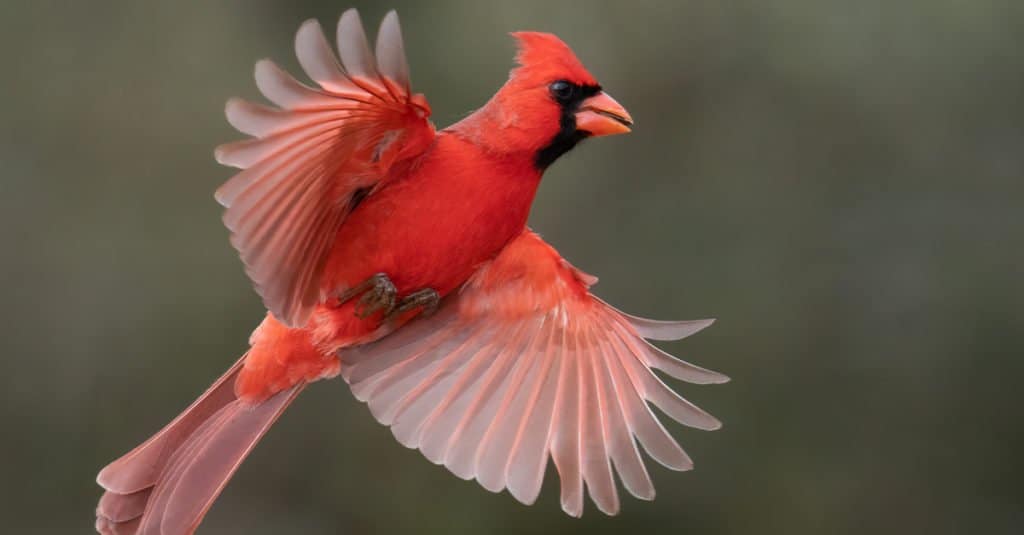
The Northern cardinal is a very common bird in the United States. You’ll find them throughout Indiana.
©Rob Palmer Photography/Shutterstock.com
Tufted Titmouse
These little birds can commonly be observed in yards and at feeders in their local area. They can be distinguished from other species by their little mohawk, which is comparable to that of cardinals. Above their beaks, titmice have a black patch that is silver-gray on top and lighter on the bottom.
On their side, underneath the wing, there may occasionally be an orange patch. All year long, the Tufted Titmouse can be seen in Indiana. Titmice will frequent the majority of seed feeders; provide them with black sunflower seeds and assorted seed mixtures.

The tufted titmouse has a grey mohawk and is resourceful, as shown here, in curating materials to build its nest.
©Jeanne Crockett/Shutterstock.com
Chickadees
Due to their “black cap” and black bib, chickadees are small little birds that are very simple to identify. Their bellies are fluffy and light, and their underparts are solid white with gray wings and backs. They are swift and inquisitive birds that can appear courageous around people when they are close to bird feeders.
Black-capped Chickadees and Carolina Chickadees are the two varieties of chickadees located in the east, and they resemble one another very closely. In so many places, depending solely on the region you are in, you may determine which one is which. Nevertheless, you can find both species in Indiana.
Both species live there year-round. Black-capped chickadees can be discovered in the northern half of the state, cross-over chickadees in the middle, and Carolina chickadees all over the southern section of the state.
Distribute black sunflower seeds and mixed seed mixes to chickadees when they approach the majority of bird feeders.
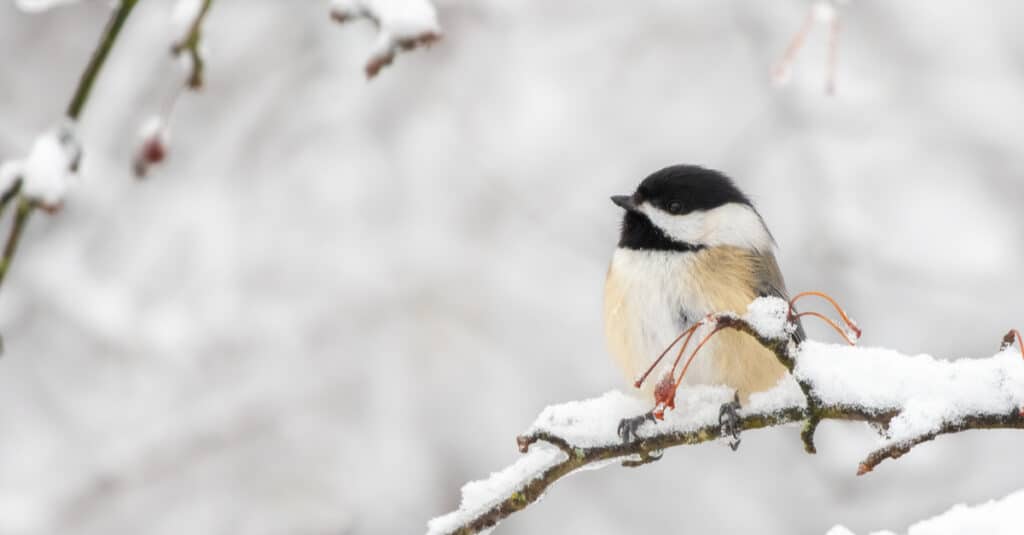
Black-capped chickadees can be found in the northern part of Indiana.
©Mr.Coffee/Shutterstock.com
Blue Jay
The Blue Jay is yet another popular bird in North America and the United States. Their heads are covered in a big blue crest that is primarily blue on top and white on the bottom. They also wear what appears to be a necklace-like black band around their necks. Their wings have white, blue, and black bars on them. Males and females are both the same color.
Another dweller of Indiana’s entire state all year round is the blue jay. They frequently frequent feeders and green spaces. Feeders with spacious perches, peanut feeders, and platform feeders are favorites of bluejays. Feed them peanuts, mixed seeds, and black sunflower seeds.
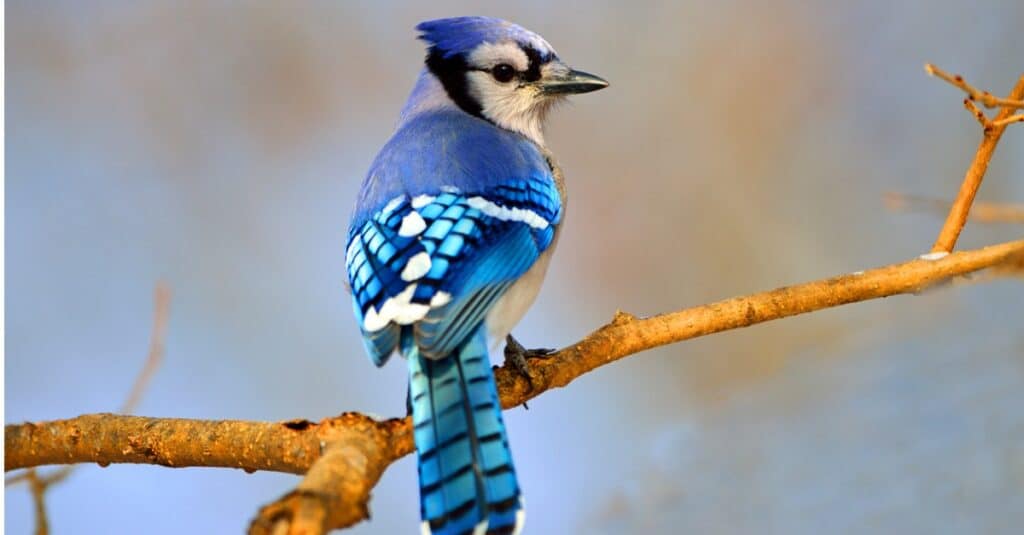
Blue jays are common birds found throughout the U.S. — including in Indiana.
©iStock.com/BrianEKushner
Eastern Bluebird
Bluebirds, as their name suggests, have blue tops and vivid reddish-orange bellies. Males and females have the same color, although blue in particular seems considerably more muted and dull in females.
They are probably the most desirable occupants of birdhouses in the United States, which has led to a surge in the bluebird house market. Although less frequent at feeders, they are fairly common in backyards. Install a birdhouse and attempt your luck at luring a mating pair.
Bluebirds migrate in several regions of North America, but not in Indiana. The Eastern Bluebird can be seen all year round in this area. For additional information, visit the Indiana Bluebird Society.
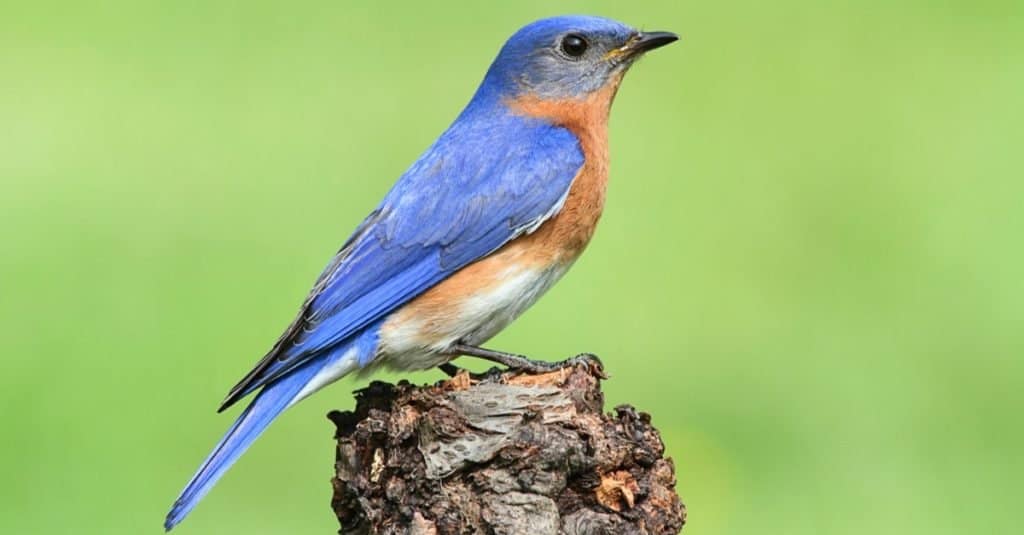
Eastern bluebirds, found in Indiana, feature a brilliant and contrasting orange chest.
©Steve Byland/Shutterstock.com
White-breasted Nuthatches
Most backyards in the region are home to nuthatches, which are frequent feeding birds. They bury nuts and seeds underneath the bark of trees, then pop them out again using their pointed beaks.
Additionally, compared to many other bird species, these birds are better able to walk steeply on trees. White-breasted nuthatches have white bellies, sides, and a strong black band on top of their heads. They have a hammer-like beak that is larger than many other feeding birds and predominantly gray and black wings.
All year long, White-breasted Nuthatches can be found in Indiana. Most seed feeders will attract nuthatches if you put out mixed seed mixtures, black sunflower seeds, or peanuts.

White breasted nuthatch birds bury nuts and seeds underneath the bark of trees, then pop them out again using their pointed beaks.
©Jim Nelson/Shutterstock.com
American Goldfinch
One of the local favorite bird species to watch at feeders is the goldfinch, particularly during the spring and summer when they are covered in bright golden feathers. They are predominantly yellow at this time, or “gold,” with black tips on their wings.
Additionally, males have a black crown atop their heads. They will migrate in the winter, losing these vibrant hues in favor of a more neutral brown or olive hue. Because of how distinct they appear in the winter, most people confuse them for a separate species.
They are easily identified at any time of the year by their finch-like beaks and black wings with white bars. All year long, goldfinches can be seen in Indiana. These birds favor feeders made of thistles.
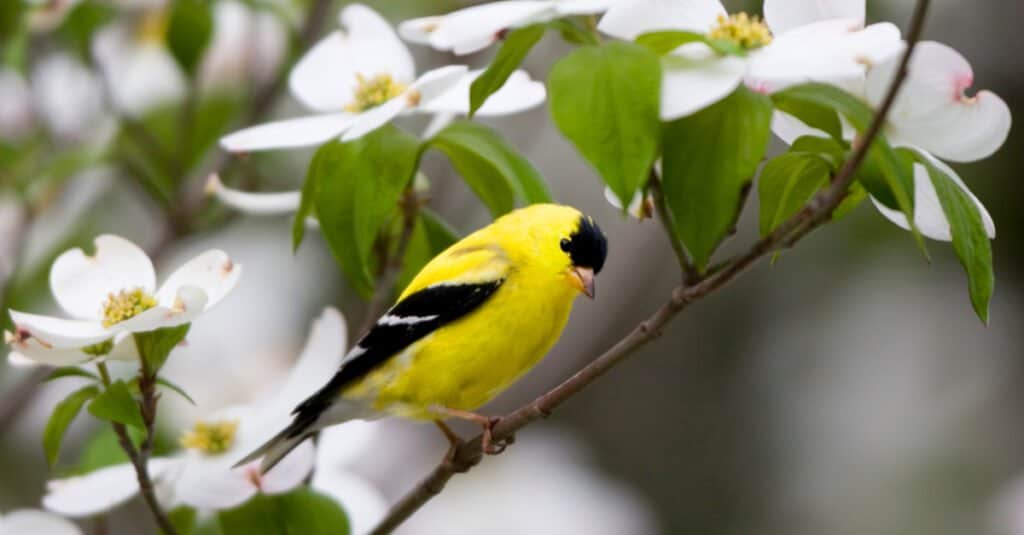
The American goldfinch is a vivid yellow which is attractive to its mate.
©Danita Delimont/Shutterstock.com
House Sparrow
The only other type of wild bird in the U.S. besides starlings that can be legally captured and mercifully killed are house sparrows, which are typically regarded as pests. These birds were brought into New York in the 1800s and have since become an invasive species that has spread rapidly throughout our nation.
They have a buffy chest and predominantly brown coloring with some black and brown striping. Males who have black masks and chests generally stand out. They are generally hostile to other birds, notably when they are close to nests and birdhouses.
All areas of Indiana have year-round populations of house sparrows. House Sparrows are aggressive and a danger to native species, just like the European Starling. They’ll consume most kinds of seeds.
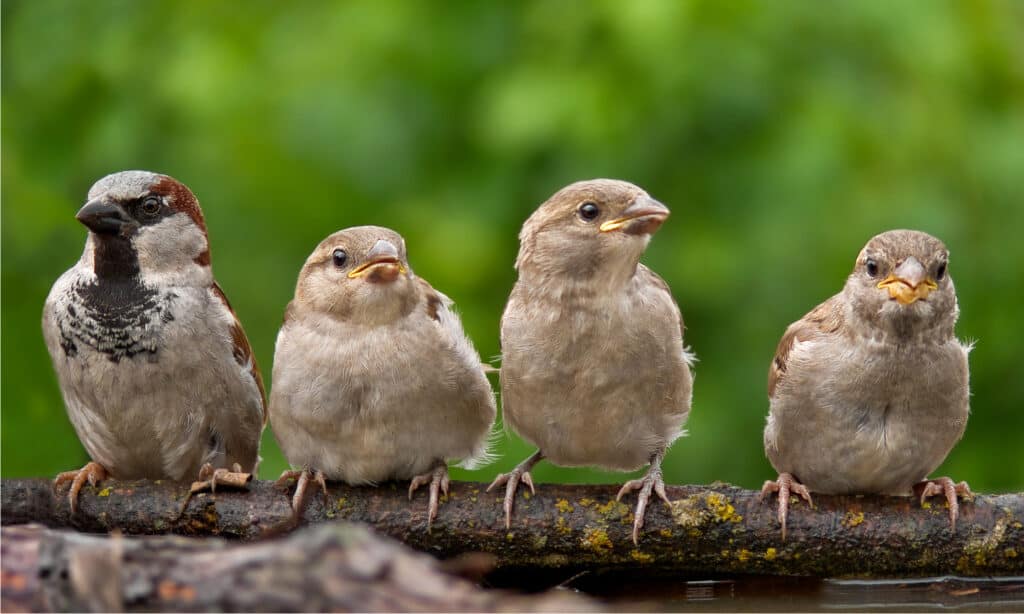
House sparrows, found throughout Indiana, are regarded as pests.
©Nick Vorobey/Shutterstock.com
Red-Bellied Woodpeckers
In eastern America, backyards, and feeders are frequently visited by these medium-sized woodpeckers. Despite being referred to as having a “red belly,” you might first notice the vivid crimson streak that runs along their backs.
They have a basic white chest with a pinkish-red patch further down in the place they call their “belly,” which is frequently hidden. The white and black striping on their wings, however, is what really helps to recognize them.
In Indiana, Red-bellied Woodpeckers are year-round residents. Red-bellied Woodpeckers can be attracted to a suet feeder, though they can occasionally eat at bird feeders as well, particularly if you provide mixes with peanuts.

As confusing as the red head may be, the red-bellied woodpecker does, in fact, have a red belly.
©rck_953/Shutterstock.com
How to Attract Birds to Your Yard
Setting out a bird feeder or two is the best and most visible approach to bring birds to your yard. I advise beginning with a straightforward window feeder, platform feeder, hopper feeder, or tube feeder. A water feature can only enhance your odds of attracting birds because birds require water not only for bathing but also for drinking.
A solar fountain may also be added because the sound of moving water will encourage more bird visits to the water. If placed outside at the appropriate time of year, many bird species will happily move into birdhouses. One of the most popular species to lure to birdhouses is the eastern bluebird.
As soon as they sense danger, birds will flee to trees, hedges, and shrubs in your yard, so make sure it contains these features. Predators are primarily kept at bay by this method.
Up Next
- Animals in Indiana
- Discover the 8 Types of Hawks in Indiana
- Best Swimming Holes In Indiana
- Discover the Deepest Lake in Indiana
The photo featured at the top of this post is © iStock.com/Flatcoater
Thank you for reading! Have some feedback for us? Contact the AZ Animals editorial team.






